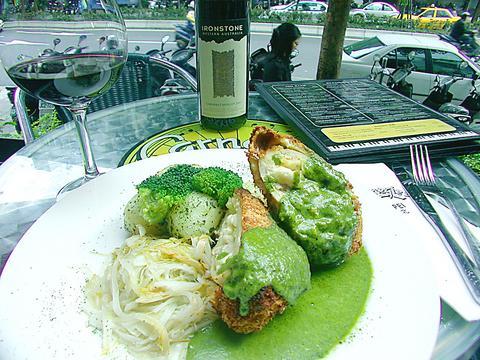If you took away the bar and dancing girls from Carnegie's you would still have a good restaurant, as a good crowd asking for tables showed at lunchtime earlier in the week. Clearly, there is something that Carnegie's does better than anyone else and that would seem to be taking care of the details.
While even relatively good restaurants in Taipei come and go, Carnegie's is here for the long run because it succeeds on four levels: First, there is the bar, which needs little introduction; then there are the club nights on Wednesday, Friday and Saturday; the tea time set of cakes and coffees in the afternoon ("Starbucks with ashtrays," is how general manager Bob Marshall described it); and last, but certainly not least, the food.
The menu is extensive and caters to a range of tastes. Whether you want to nibble on bar favorites such as quesadillas (NT$240) or mixed spicy sausages, or tuck in to a large fillet of North Sea cod in a crispy beer batter with thick-cut French fries, mushy peas and salad (NT$450), Carnegie's provides.

PHOTO: JULES QUARTLY, TAIPEI TIMES
There are eight starters, 14 main courses and four desserts on the a la carte part of the menu. Added to this are six types of salads and five items in the innovative British "Traditional Pub Fayre" section, including liver and onions (NT$330) and shepherds pie (NT$360). There is also a comprehensive selection of pasta dishes and five rice-and-curry dishes to choose from, including a chicken biryani (NT$390), which is earning rave reviews from the English ex-pat community.
We chose the chicken and mushroom pie (NT$360), rolled chicken breast (NT$450) and grilled port medallions (NT$490), all of which were larger than generous portions. Each meal came with its own tailored vegetable selection, so the pork came with red cabbage and apple sauce, flavored with cloves and nutmeg. The breaded and rolled chicken and goat's cheese arrived with caramelized Belgian endives and boiled potatoes, which complemented the pesto sauce. The chicken pie arrived with a large puff pastry crust and a selection of vegetables with mashed potatoes.
Marshall said the menu was changed in October and food sales went up 35 percent since then. "There has been a lot of development. It has been really successful. Basically, we wanted to put food on the menu that we wanted to eat ourselves."

This month the government ordered a one-year block of Xiaohongshu (小紅書) or Rednote, a Chinese social media platform with more than 3 million users in Taiwan. The government pointed to widespread fraud activity on the platform, along with cybersecurity failures. Officials said that they had reached out to the company and asked it to change. However, they received no response. The pro-China parties, the Chinese Nationalist Party (KMT) and Taiwan People’s Party (TPP), immediately swung into action, denouncing the ban as an attack on free speech. This “free speech” claim was then echoed by the People’s Republic of China (PRC),

Exceptions to the rule are sometimes revealing. For a brief few years, there was an emerging ideological split between the Democratic Progressive Party (DPP) and Chinese Nationalist Party (KMT) that appeared to be pushing the DPP in a direction that would be considered more liberal, and the KMT more conservative. In the previous column, “The KMT-DPP’s bureaucrat-led developmental state” (Dec. 11, page 12), we examined how Taiwan’s democratic system developed, and how both the two main parties largely accepted a similar consensus on how Taiwan should be run domestically and did not split along the left-right lines more familiar in

Many people in Taiwan first learned about universal basic income (UBI) — the idea that the government should provide regular, no-strings-attached payments to each citizen — in 2019. While seeking the Democratic nomination for the 2020 US presidential election, Andrew Yang, a politician of Taiwanese descent, said that, if elected, he’d institute a UBI of US$1,000 per month to “get the economic boot off of people’s throats, allowing them to lift their heads up, breathe, and get excited for the future.” His campaign petered out, but the concept of UBI hasn’t gone away. Throughout the industrialized world, there are fears that

Most heroes are remembered for the battles they fought. Taiwan’s Black Bat Squadron is remembered for flying into Chinese airspace 838 times between 1953 and 1967, and for the 148 men whose sacrifice bought the intelligence that kept Taiwan secure. Two-thirds of the squadron died carrying out missions most people wouldn’t learn about for another 40 years. The squadron lost 15 aircraft and 148 crew members over those 14 years, making it the deadliest unit in Taiwan’s military history by casualty rate. They flew at night, often at low altitudes, straight into some of the most heavily defended airspace in Asia.